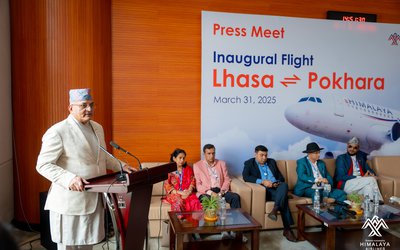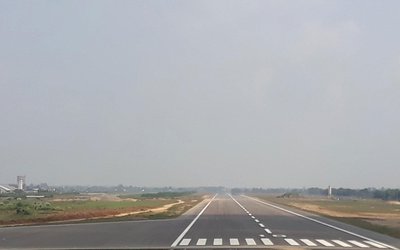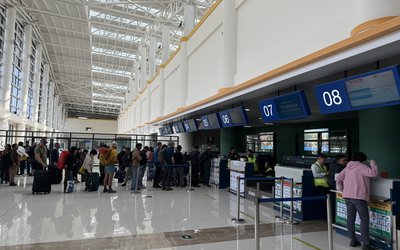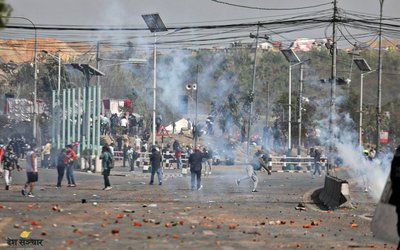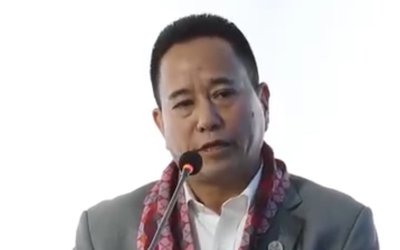
With more Chinese tourists coming to Nepal, new cooperative ventures appear to be in the pipeline in Nepal-China Civil Aviation sector. There are several Chinese Airlines already eyeing the sector for more flights.
Four Chinese Airlines are offering their services to Kathmandu. They include Air China, China Southern, China Eastern and Sichuan Airlines, which have fetched over 200,000 Chinese tourists to Nepal till April 25 last year.
Following the April Earthquake and border blockade resulting in the scarcity of fuel, two Chinese Airlines stopped their scheduled flights to Kathmandu. Once the agitation in Madhesh ends and the supply of petroleum products resumes, the two Chinese Airlines will be likely to resume their flights.
Although the supply of petroleum products badly hurt the operation of the Chinese Airlines, Nepal has seen other two important developments in the civil aviation sector. Delayed for several times in the past two years with unknown reasons, the decisions taken by Ministry of Tourism, Culture and Civil Aviation to bring remaining four Chinese-made aircrafts to add to the fleet of Nepal Airlines and finalize the agreement on Regional International Airport Pokhara during Prime Minister K.P. Sharma Oli’s forthcoming visit to China have raised the hope that Nepal-China aviation cooperation will reach new heights.
Both the deals were finalized almost two years ago but the Nepalese officials delayed the implementation of the decision, citing one or the other reason.
Nepal Airlines has already imported MA 60 and Y-12 Aircraft, which are currently flying in the trunk routes and remote routes of Nepal. Built by AVIC International Holding Corporation, the two aircrafts are flying in Nepalese sky. Ministry of Culture, Tourism and Civil Aviation signed the agreement with AVIC International, a Chinese government undertaking, to purchase six Chinese Aircraft in 2013.
“There are four aircrafts delivered to us in China. Ministry of Tourism, Culture and Civil Aviation has been looking at the matter,” said Sugat Ratna Kansakar, managing director of Nepal Airlines. With the signing of the agreements, Nepal will acquire two aircraft - 19-seater Harbin Y12E and 58-seater Modern Ark 60 (MA60) - on grant and three Harbin Y12E and a MA60 on concessional loan.
The Chinese government has agreed to provide grants and concessional loans in assistance worth 408 million yuan (approximately 6.7 billion Nepalese currency) to acquire and purchase six China made aircraft.
Out of the total assistance of 180 million yuan (approximately 2.9 billion Nepalese currency) will be used to acquire one MA 60 and one Y12E aircraft on grant basis and up to 228 million yuan ( approximately 3.7 billion Nepalese currency) will be used to purchase one MA60 and three Y12E aircraft on loan basis.
Along with Chinese Exim Bank loans to purchase Chinese Aircraft, Chinese government has agreed to provide 215.96 million loan to Pokhara International Airport. The deal has already been inked in May 2014.
Nepal government has recently completed the negotiations with Chinese Exim Bank for a 215.96 million loan to the regional international airport in Pokhara. With the increasing assistance from China in Nepal’s aviation sector, Nepal and China should focus on signing the Air Service Agreement as early as possible.
History of Chinese Aircrafts
This is not the first time Nepal has acquired Chinese-built aircraft. Nepal received the first Chinese aircraft way back in 1963, with 12-seater Feng Shou-2 Harvesters, which were brought into service by then Royal Nepal Airlines, opening up the kingdom’s more remote routes. The two Feng Shou-2 aircrafts did not enter scheduled services but were placed for Royal Visits.
As Nepal and China have been making efforts to enhance their cooperation in the aviation sector, high level Nepalese government officials, Chinese Ambassador to Nepal, Nepalese business communities, and private airline operators participated in a symposium that discussed the related matters.
Organized by Asia Pacific Daily (APD), which is run under Chinese news agency Xinhua, the half-day seminar on "Aviation Cooperation between Nepal and China: Opportunities and Challenges" discussed various issues regarding Nepal-China cooperation in aviation.
Jointly inaugurated by Minister of Tourism, Culture and Civil Aviation Ananda Prasad Pokharel and Chinese Ambassador to Nepal Wu Chuntai, the symposium on Aviation Cooperation between Nepal and China discussed various issues.
During the program, Nepal policymakers and private sectors discussed prospects of aviation cooperation and explore new avenues for the country by bringing together the aviation experts in a common platform.
“The government has already taken initiative to import the remaining four Chinese aircraft ordered by Nepal Airlines,” said Minister for Tourism, Culture and Civil Aviation Pokharel while inaugurating the symposium. “With the induction of two Chinese aircrafts, Nepal Airlines is providing services to different domestic sector.”
Chinese ambassador to Nepal Wu Chuntai said that China is eager to provide any kind of support to Nepal’s economic development. “A close neighbor China, we want to share our development with Nepal. China is ready to provide Nepal with the necessary support in infrastructure development including hydropower and aviation,” said ambassador Chuntai.
Managing Director of Nepal Airlines Sugat Ratna Kansakar held the view that Nepal Airlines will induct remaining Chinese made aircraft to extend its domestic sector. “Nepal Airlines is planning to add two more wide body aircraft to increase its flights to major cities of China including Shanghai and Gunzhao,” said Kansakar.
President of Airlines Operation Association Rameshwor Thapa said there is a lot of possibility to enhance cooperation between Nepal and China in aviation sector given the rise of domestic market in Nepal.
As China has technology and resources, Nepal can benefit from the opportunity. Director General of Civil Aviation Authority Nepal Sajeev Gautam said Nepal needs Chinese support to modernize Nepal’s aviation sector.
Even as political instability and political indecision may delay the process, Nepal China aviation cooperation is now a reality.
- BIMSTEC SUMMIT: Nepal’s Stand
- Apr 11, 2025
- IME GROUP: Expands Into Paper Industry
- Mar 24, 2025
- CPN UML: Instigated By India
- Mar 23, 2025
- ADB’S CHIEF ECONOMIST: Nepal Reduces Poverty
- Mar 11, 2025
- FM DR. DEUBA: A Successful Visit
- Mar 11, 2025
